Tanks under Fuentes de Ebro
“The Republican government after the military setbacks of 1936 of the year decided to turn the tide, and for this to conduct a decisive offensive in the area of the Aragon front in 1937. Belief in success was based on excellence in engineering. The fact is that it was then that the Republicans received a new batch of modern tanks BT-5 and T-26, which were decidedly superior to the machine gun tanks of the rebels. The direction of the main attack was to be the small town of Fuentes de Ebro, through which there was a strategically important road to Zaragoza, and from which to it on a flat terrain was no more than 50 km.
The operation was to be led by General Karel Sverchevsky - a Pole, known in Spain as “Walter”. The following forces were assigned to him for the offensive: the 15-I International Brigade, of the four infantry battalions of 600 fighters in each, and another battery of anti-tank guns. Her commander was a Croat Vladimir Kopik, who began his military career in the Austro-Hungarian army during the First World War. The English battalion was the most "fired" and fighting in this brigade. It consisted of three infantry companies, armed with Mosin rifles, and a company equipped with light machine guns DP-27 and also machine-tool "Maxims". Half the battalion was from Spanish volunteers. They were followed by a battalion of Americans "Lincoln-Washington" merged from two to one in July 1937, which everyone called "Lincolns". In the 24 th Spanish battalion, in addition to the Spaniards themselves, there were Latin Americans, including even Cubans. “Mac-papes” was the name of another soldier, now Canadian battalion (the abbreviated name Mackenzie Papino is the name of the two leaders of the uprising in Canada against England in 1837).
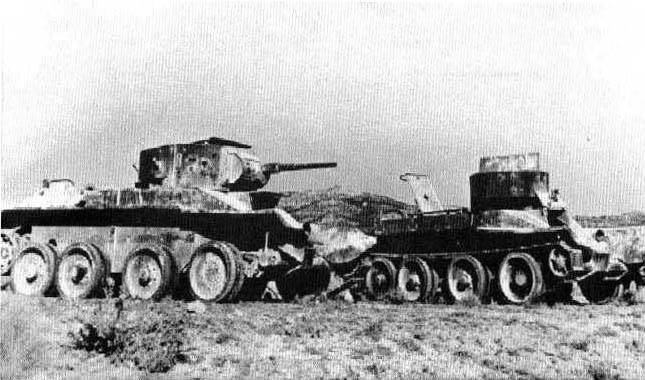
BT-5 tanks, shot down under Fuentes de Ebro.
10 August 1937 Fifty BT-5 tanks were delivered to Spain, of which a regiment of heavy tanks was formed, to which was added a company of armored cars and another company of anti-tank guns. BT-5 among the tanks that fought in Spain, was probably the best. And not so much in terms of weapons and reservations, but in terms of speed and maneuverability. Commanded the "regiment" Lieutenant Colonel S. Kondratiev. Many of his assistants were also Soviet military advisers, and the Bulgarian was his deputy. The regiment consisted of three companies, each had three divisions, and each division had five tanks. The commander’s vehicles had radio stations and square or rectangular white markings, but usually the cars were distinguished by their individual license plates on the towers. The opponents of the Republicans on the Aragon front were the 5 Corps of Nationalists, whose main forces were located in the cities of Belchite and Fuentes, around which a circular defense was arranged. The units that defended Fuentes de Ebro were part of the 52 Division and included three companies of the 7 Infantry Regiment, a company of militiamen from the Spanish Phalanx organization (fit only for the second echelon of defense) and one battery of 10 light guns th artillery regiment. Then they were sent to the aid of three more divisions and the Italian-Spanish brigade "Blue Arrows". In this brigade were three "camps" of the Moroccan cavalry; The 225 Battalion, four batteries with 65-, 75-, 105- and 155-mm guns, and the “Foreign Legion” battalion, as well as parts of the “Spanish phalanx” assembled from everywhere.
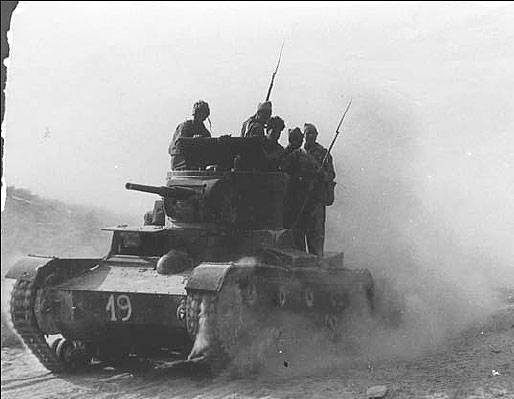
Soviet tank T-26 with troops on armor in the Belchite area.
In October, a calm was established at the front, which made it possible to develop an operation plan, according to which it was supposed to take the city from the flanks with the help of tanks. But here aviation nationalists unexpectedly destroyed a convoy of republican trucks with fuel and ammunition, and the commanders decided that since the nationalists knew about the convoy, they also knew about the tanks, and if so, then the element of surprise from their use was already lost and it wasn’t worth starting up with flank attacks!
Federation of anarchists of Iberia distributes to the people weapon.
As a result, they decided to attack the city frontally with the support of artillery and aviation. It was supposed to land a tank landing, which was supposed to strike at the nationalists from the rear. But they didn’t react to the development of the idea that was so unworked in practice without special attention - they say, "we will put people on tanks, and then they will do everything themselves." Ways of interaction of tanks with infantry until the beginning of the operation were not worked out, in short, everything was similar to our fatal "the main thing to start, maybe we will break through."
Soviet tank T-26, turned into an altar for the mass. Since the Republicans did not complain about “opium for the people”, it remains to assume that the car is a trophy, as well as the fact that we have a car that fell to the nationalists.
During the assault, Fuentes de Ebro did not pay attention to the positive experience of sharing artillery and tanks in the successful capture of the city of Quinto in August 1937. In addition, people were just tired after the fierce battles for the city of Balchite, and harsh trench life contributed little to raising morale soldier of the republican army. In addition, the brigade was international, the moral and political situation inside it was complex and controversial, and it is clear that all of this had a very negative effect on her readiness for the offensive as a whole. At headquarters, too, there were disagreements about the offensive, but, nevertheless, it was decided to start it, and it began on October 11.
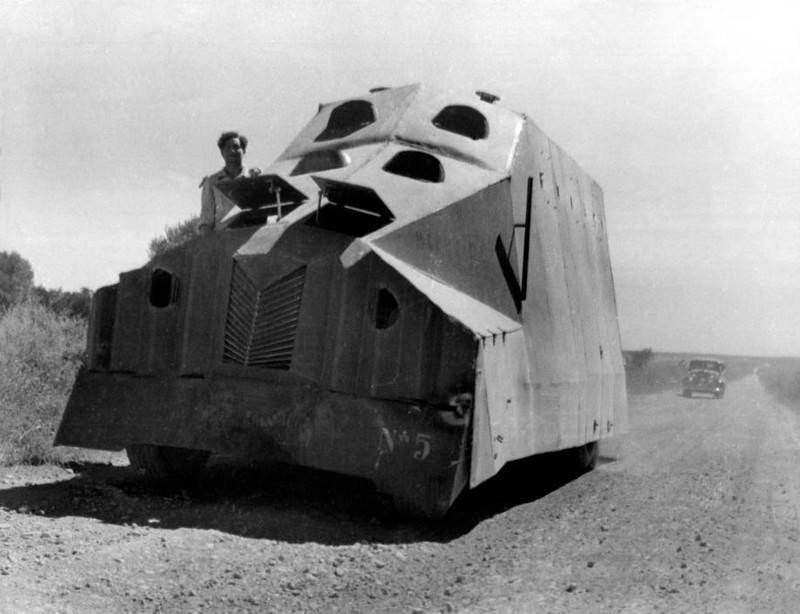
The Spaniards had very few of their tanks, but the Spanish workers riveted such armored cars and used them ... as appropriate.
At o'clock in the morning, Kondratyev gathered the officers of his regiment for the last briefing, after which the tanks (and they were only five kilometers away from the city!) Began to move into the area of attack. The infantry assault forces had to go to the tanks on foot, so it took more time than planned.
Some of the home-made Spanish BAs looked monstrous!
And here, at dawn, the artillery of the Franco, noticing the movement in close proximity to their positions, opened fire. Republicans began to suffer losses, even without joining the battle! The distance to the Franco trenches was only from 400 to 800. The front, on which the Republicans were, was as much as four kilometers, but their troops were at different distances from them. The British on the left flank of the river, along the road to the city stood "Lincoln", the farthest behind the road were Canadians "McPaps."
The terrain on which the offensive was to take place was completely carved by ravines and irrigation canals. In some places it was covered with vegetation, but on the whole it was a plain that was clearly visible from the city. Because of the general confusion of artillery preparation, the Republicans were able to start only on 10.00 in the morning, and they carried it out with only two batteries. They fired several volleys and ceased firing. The “element of surprise,” if one still existed, was now completely lost, and the nationalists even had time to tighten up their reserves.
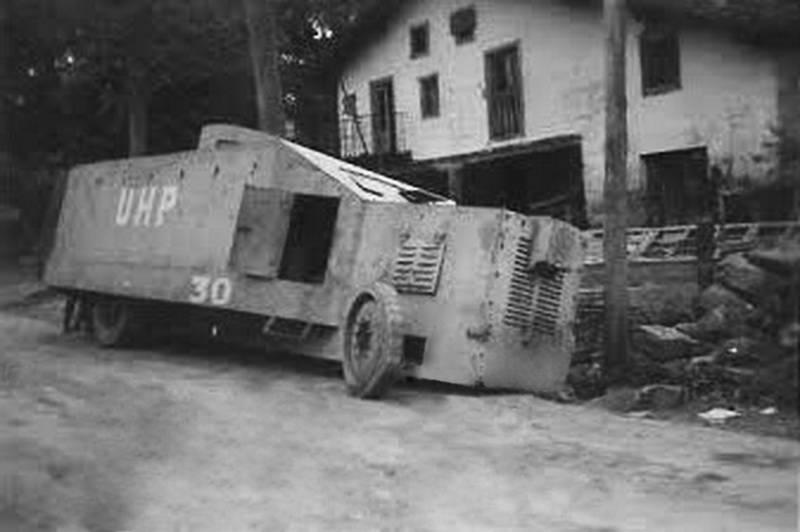
That was the end of most of these self-made BA!
But the attack did not begin immediately after the artillery preparation. They waited for the tanks, which decided to refuel, to approach. Why didn't they do it the day before, nobody knew. Most likely, they simply did not think about it. By noon, the motors boomed in the sky, and Natasha appeared over the city — single-engine light Soviet PZ bombers in the amount of ... 18 vehicles. They made only one run, dropped bombs from horizontal flight and flew away. It is not surprising that the results of the bombing were similar to the results of the artillery preparation. And now all hope was on the rapid tank attack with the landing of the Spanish battalion 24 on armor.
And now let's remember how the BT-5 tank looked like that it had a high and rather narrow engine part sticking out behind the muffler, and there were no handrails on it. Therefore, it was hardly suitable for the transport of troops; he simply had nothing to hold onto it. Only the commander’s tanks had an antenna in the form of a handrail on the turret, but it was still inconvenient for all the paratroopers to hold on to it, besides, there were still few such tanks.
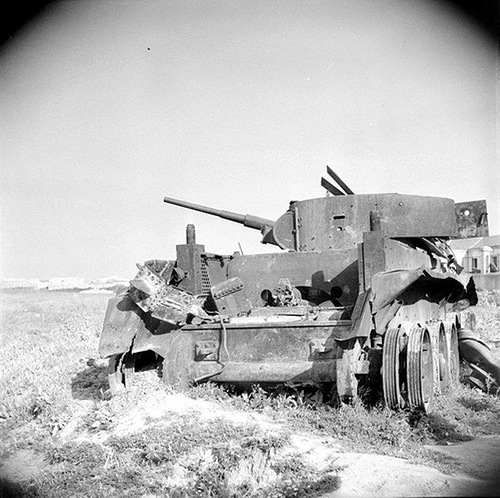
Wounded BT-5. Fuentes de Ebro.
Only about two o'clock in the afternoon the order to launch the attack finally sounded, although preparations for it began at four (!) O'clock in the morning. The number of tanks involved in this battle: from 40 to 48, it was unprecedented by the standards of that time! On all tanks standing along the front, the commanders who looked out from the towers waved flags, passing the “Do as I do!” Signal, and disappeared inside. But again, the BT-5 had no intercom: to give the order to start moving, the commander pushed the driver with his foot in the back. Motors roared and, leading at the enemy a quick fire and rumbling caterpillars, the tanks rushed to the city. But it was not without embarrassment: the Spaniards' infantry, who was sitting along the front in the trenches, as it turned out, did not warn anyone about the tanks, and she began to shoot at a fright, from where it was unclear from where tanks appeared in the rear. The tank landing party immediately answered her, but, fortunately, due to the high speed, neither of them nor the others got into each other. As soon as the tanks rushed over the trenches, the infantrymen in them immediately understood what was happening and ran for the tanks with shouts of “Hurray!”, But they were simply unable to catch up with the BT-5, rushing at full speed.
Visibility for drivers due to the high grass was poor. For example, tanker Robert Gladnik saw only the spire of Fuentes Church in 90 meters ahead of him. His tank jumped on potholes so that it lost almost all of its troops, and then his car got into a deep ravine. Nobody answered his calls on the radio, but the motor worked, and he managed to choose from the ravine. After that, he shot the entire ammunition in the city and left the battlefield ...
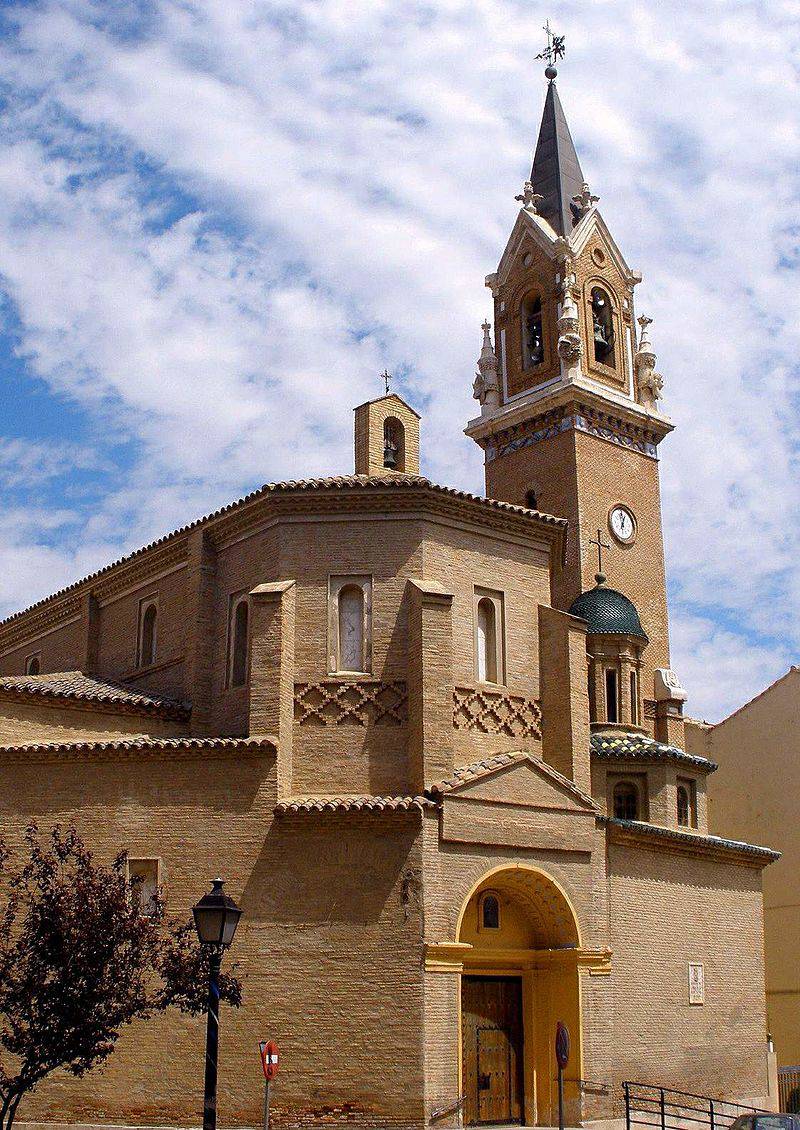
Here it is the spire of the church of St.. Michael of the city of Fuentes de Ebro, still preserved.
William Kardash in his tank overcame a ravine, but his tank was set on fire by a bottle with a combustible mixture near the city itself. The engine stalled, but when the nationalists tried to approach the tank, Kardash opened machine gun fire at them. Then the fire reached the fighting compartment, and the crew had to leave the car. Fortunately, he was saved by the crew of another car passing by.
"Tanks rushed, raising the wind," as a result, many paratroopers were dropped from armor, while others fell under heavy fire of the enemy. The drivers of the area did not know, and several cars got into the canals and ravines, and they could not get out of them without help. But, despite all these difficulties, the attack continued! Having avoided the sad fate of their comrades, several tanks broke barbed-wire obstacles and entered the city, but they found it difficult to maneuver in the narrow streets of the medieval Spanish city, and as a result tankers lost several tanks in the city itself and were forced to retreat.
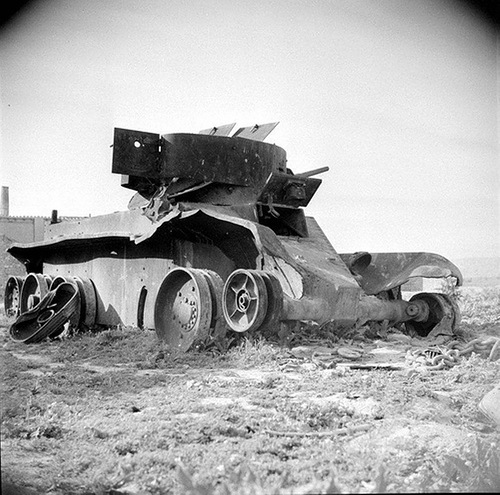
This BT, shot from the other side.
As for the internationalist infantry, then ... she courageously followed the tanks, but ... the person cannot run after the horse (think of the "Ice Battle", where the infantry was depicted next to the knights in the schemes!), And even more so for the tanks, especially the tanks BT
The commander of the English battalion raised his men to the attack, but was immediately killed, and his battalion was forced to lie down under heavy machine-gun fire from the Franco side. The Americans walked almost half the distance to the enemy trenches, but were forced to lie down and dig in "under the very nose" of the nationalists. The situation could save only a desperate dash! Or approach reserves! "McPaps" from the enemy were the farthest. And they managed to advance a few hundred meters, but then both the commander and the commissar were killed by enemy bullets. The interaction between the units under enemy fire could not be established. The Republican machine gun fire returned to be of no effect, and then the Republican battery commander received a ridiculous order: to advance with the guns and help the infantry! As a result, he lost a good position, but he did not find a new one, and all this time his tools were silent.
By the end of the battle, the Brigadiers lay down on the whole space between their lines and the enemy's trenches, and the soldiers began to dig single cells. The soil was traditionally Spanish: red earth and stones. The orderlies who carried the wounded out were only able to finish their work by night. But even before dark, the brigade was taken to the old positions. Some, not heavily damaged tanks managed to pull out.
McPaps lost 60 people killed and more than 100 injured. Of the three mouth commanders, two were killed, the third seriously wounded.
The Lincoln's casualties made 18 people killed, including the commander of a machine-gun company and about 50 injured. The British lost the fewest killed: only six, but they had a lot of wounded. The Spanish battalion, which participated in the tank breakthrough, suffered very heavy losses. Well, and the landing, which was in the rear without support, was all surrounded by Francoists and completely destroyed. Among the gunners were several wounded.
Tankers Kondratieff lost 16 crews killed, and his deputy was killed. In just one day, the Soviet tankers thus suffered the heaviest casualties of the entire war! Different sources give different information on the number of shot down tanks: from 16 to 28, but it is obvious that they accounted for 38% - 40% of the number of vehicles involved.
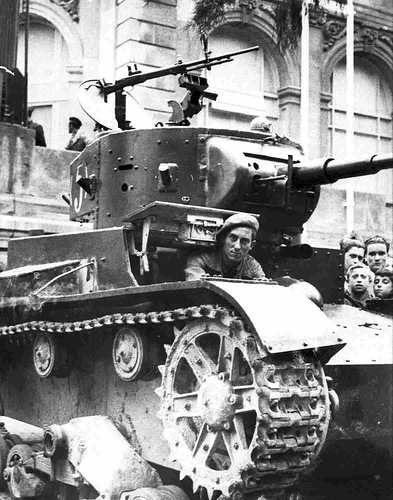
Republican T-26 with anti-aircraft machine gun.
Interestingly, the sad experience of a tank landing at Fuentes de Ebro was not taken into account by the Soviet command during the Great Patriotic War. It was widely used, while our commanders didn’t force him to take heavy losses.
The fate of S. Kondratiev’s comorus itself turned out to be sad: during the Finnish war, part of it on the Karelian Isthmus was surrounded, it didn’t come to help, the losses were huge, and he came out of the encirclement and decided to commit suicide because just do not forgive. Then they shot General Pavlov. He was compromised that in Spain he “morally decayed”, but after his return “from there” for some reason they closed their eyes. But then the 41 began, and the new defeats were no longer forgiven to him ... Well, the story of the Spanish tanks, in fact, will be continued in the next article.
Fig. A.Shepsa
(To be continued)
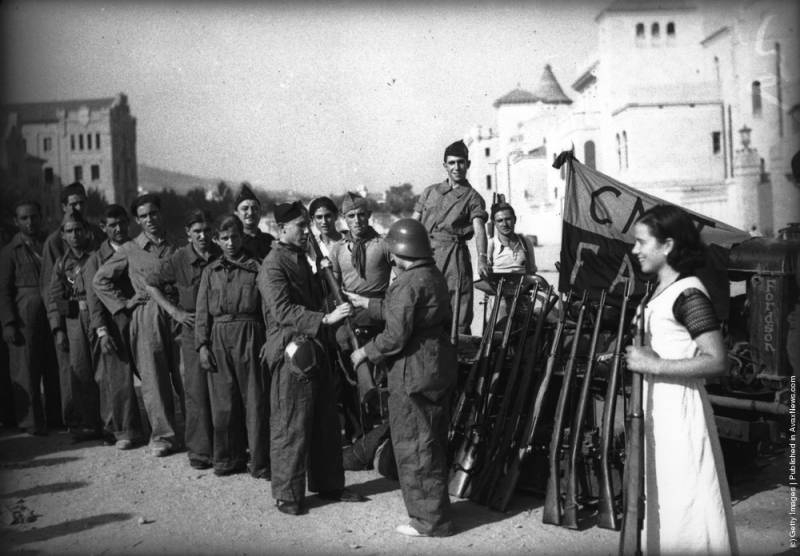
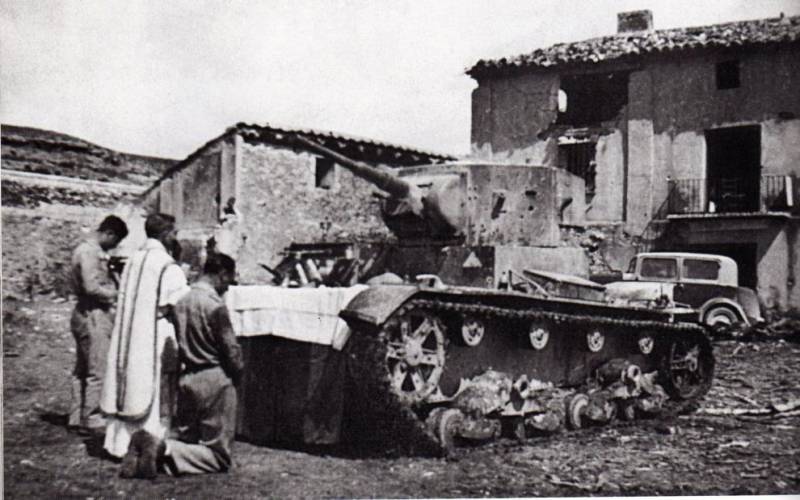
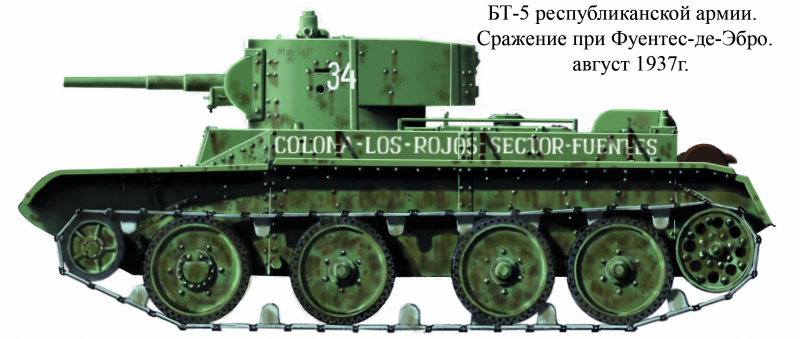
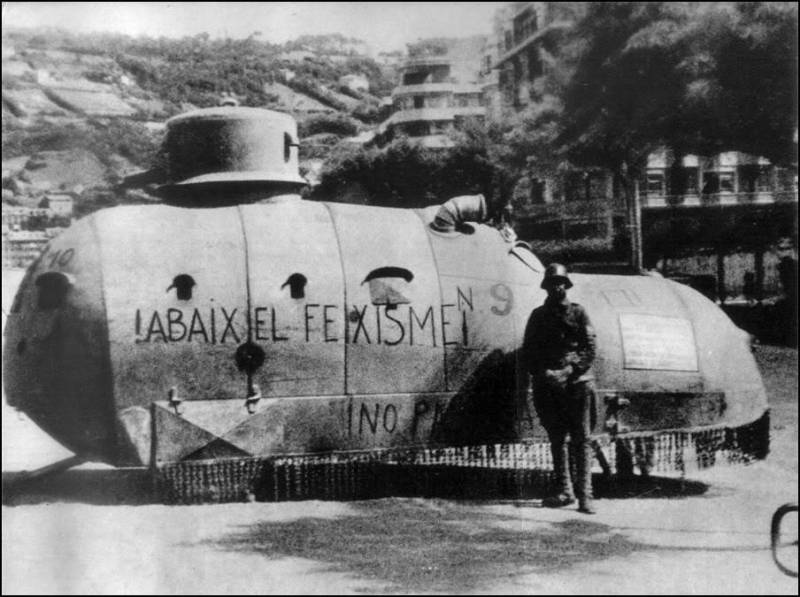
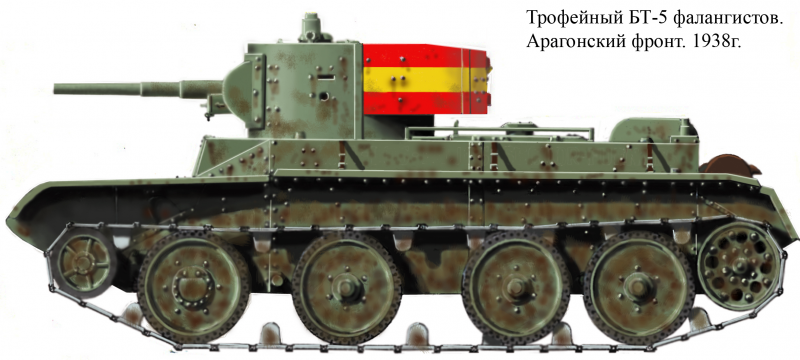
Information